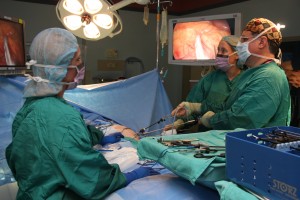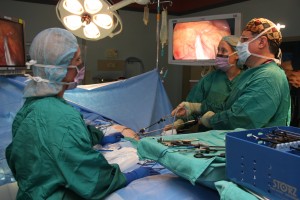
Is Single Port Surgery Right for Me?
-
Over the past twenty years, minimally invasive surgery has been successful in reducing the large scars associated with traditional surgery to a few scars less than one inch in length.

As a result, our patients have experienced faster, easier recoveries with less pain and fewer complications. During the past ten years, tele-manipulator surgery (commonly called “robotic”) surgery has been responsible for an increase in the number of procedures performed laparoscopically. Today, in 2013, surgery has advanced to the next level of minimally invasive surgery. Many procedures can now be successfully performed with fewer scars and smaller scars than with robotic surgery through a surgical technique called single port (or reduced port) surgery.
Reduced Port Surgical techniques allow surgeons to operate through one incision (vs. four or five for the standard laparoscopic or robotic surgery) as well as three and five millimeter incisions (as compared to eight and 10mm incisions with laparoscopic or robotic surgery). Aside from having less scarring, the other benefits we may see are improved recovery, decreased pain and less risk of complications such as hernia and infection in subsequent years.
Procedures that can currently be performed using Single Port Surgery:
- Removing a kidney (nephrectomy)
- Removing the bladder (cystectomy)
- Removing the prostate (prostatectomy)
- Freezing cancerous tissue to halt growth (cryoablation)
- Treating pelvic organ prolapse in women (sacrocolpopexy)
- Treating an enlargement of the veins within the scrotum (varicocele)
- Reconstructing the urinary tract after tumor removal
Surgeons trained and actively performing reduced port surgery are able to hide incisions for removal of gallbladders, the uterus, the ovaries, the appendix and even parts of the colon almost completely within the belly button. As with most new techniques, they are used first for patients with non-cancer issues, but as techniques have improved, we are now able to offer these to cancer patients as well.
To be considered for single port surgery, patients need to meet with a surgeon who performs this type of surgery routinely, otherwise, they may not have access to these new techniques. This surgical technique is not appropriate for patients who are obese or who have had major abdominal surgeries because the surgeon requires maximum visibility and movement inside the abdomen.
Fox Chase cancer center has a rich history of surgical innovation. One of our reduced port surgeons was the FIRST to perform completely robotic surgeries in the Philadelphia area in 2002. This same surgeon performed the first Single Port Surgeries in the world in 2007 in both abdominal and gynecologic surgery. Our single port surgeons have trained and lectured throughout the world and regularly teach their techniques to colleagues internationally.
To learn more about single port surgery, call 888-369-2427.
Stephanie A. King, MD, Director, Minimally Invasive Gynecologic Surgery and Postgraduate Training, Fox Chase Cancer Center
Paul G. Curcillo, II, MD, FACS, Director, Minimally Invasive Surgical Initiatives and Development, Fox Chase Cancer Center
